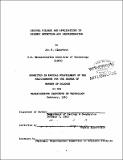Digital filters and applications to seismic detection and discrimination
Author(s)
Claerbout, Jon F
DownloadFull printable version (28.96Mb)
Other Contributors
Massachusetts Institute of Technology. Dept. of Geology and Geophysics.
Advisor
Stephen M. Simpson, Jr.
Terms of use
Metadata
Show full item recordAbstract
The first part of this thesis is concerned with the mathematics of filtering in discrete time. Filters are defined for the purposes of 1) condensing waveforms into impulsive functions 2) wave shaping 3) noise suppression 4) signal detection according to the criterion of maximum signal-to-noise output at an instant and 5) the same over an interval. The behavior of the complex Fourier transforms of some of these filters is considered and connection is made with the theory of orthogonal polynomials. This leads to the possibility of a feed back representation of these filters. In the second part, computational experiments are described in which digital filters are applied to seismic body waves to i) try to determine whether the first arrival is up or down on a seismogram corrupted with microseismic noise, 2) increase signal-to-noise ratio on seismograms where noise has almost obliterated signal 3) assign polarity to each of two seismic first motion wavelets so they can be termed "same" or "opposite," 4) remove spectrum of seismometer from data, 5) investigate the time varying spectral structure of underground nuclear shot seismograms.
Description
Thesis (M.S.)--Massachusetts Institute of Technology, Dept. of Geology and Geophysics, 1963. "February 1963." Includes bibliographical references (leaf 89).
Date issued
1963Department
Massachusetts Institute of Technology. Department of Geology and Geophysics; Massachusetts Institute of Technology. Department of Earth, Atmospheric, and Planetary SciencesPublisher
Massachusetts Institute of Technology
Keywords
Geology and Geophysics.